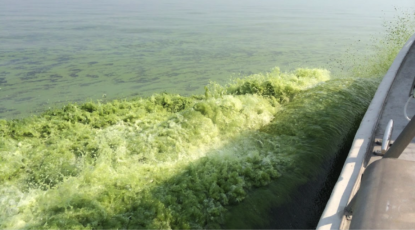Environment
-
U-M-led school for oceanographers in Africa receives funding from Schmidt Sciences
The Coastal Ocean Environment Summer School in Nigeria and Ghana was founded by Brian Arbic, a physical oceanographer and U-M professor in earth and environmental sciences. Google CEO Eric Schmidt and Wendy Schmidt are founders of Schmidt Sciences.
-
U-M lands $6.5M center to study links between Great Lakes algal blooms, human health
Researchers at U-M have been awarded a five-year federal grant to study links between climate change, harmful algal blooms, and human health. Increased precipitation, more powerful storms, and warming Great Lakes waters encourage the proliferation of algal blooms composed of cyanobacteria.
-
Most local officials support rooftop solar, a majority opposes nuclear power
Michigan’s local leaders overwhelmingly support adding rooftop solar infrastructure in their communities, while a majority strongly oppose developing nuclear power. According to the Michigan Public Policy Survey, 86% of local government leader respondents either strongly or somewhat support adding rooftop solar panels.
-
Earliest recorded ‘ice-out’ date on Douglas Lake at U-M Biological Station
The ice-out, declared on March 16 this year, comes after the latest-recorded Douglas Lake “ice-in” occurred on Jan. 6 — making this the shortest season of lake ice cover recorded at the BioStation in Northern Michigan: just 70 days.
-
Could riding older school buses hinder student performance?
Students who ride newer, cleaner-air buses to school have improved academic performance, according to a U-M study that linked school bus funding information with standardized test scores and found improvements in reading/language arts and math scores when the oldest buses were replaced with newer vehicles.
-
Legacy in land: Protecting rare fens, century farms, and other natural habitats in Michigan
Prairie fens, which take thousands of years to develop, exist predominantly in southern lower Michigan and occur where cold, alkaline groundwater bubbles to the surface. The springs feed rivers and lakes with clean water. At the LaCroix Legacy Land Conservancy, alumna Susan Morley is dedicated to the voluntary conservation of locally important land.
-
U-M Biological Station activates snowpack sensor to study changing winters
Increasingly common rain-on-snow weather events are reducing snowpack and washing away nutrients from soils to our streams and lakes. This winter, snow science researchers at U-M’s Biological Station are tracking the snowpack at an hourly rate to get a deeper understanding of the complexities of global environmental change.
-
Food from urban agriculture has surprisingly high carbon footprint
A new U-M-led international study finds that fruits and vegetables grown in urban farms and gardens have a carbon footprint that is, on average, six times greater than conventionally grown produce. However, a few city-grown crops equaled or outperformed conventional agriculture under certain conditions.
-
Art or infrastructure? Depends on the climate
‘Migration Stage,’ an outdoor installation along Seattle’s Elliot Bay, serves a once-and-future purpose, says artist Buster Simpson, MFA ’69. Its movable ‘kit of parts’ provides a unique place to gather, while it functions as ‘sea armor’ to protect shoreline infrastructure against extreme storms. (Image credit: Joe Freeman Jr.)










